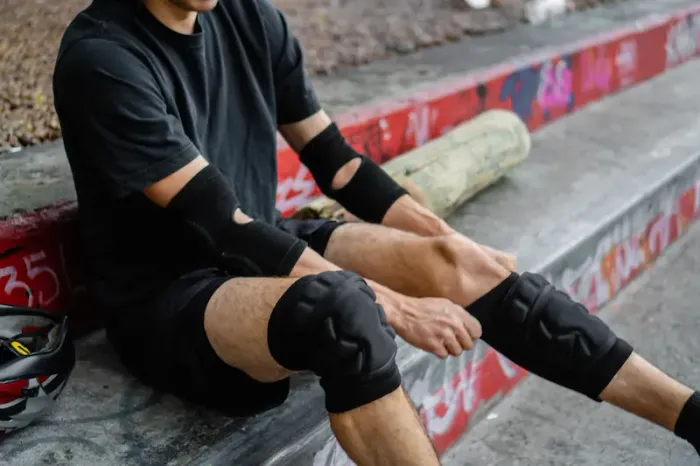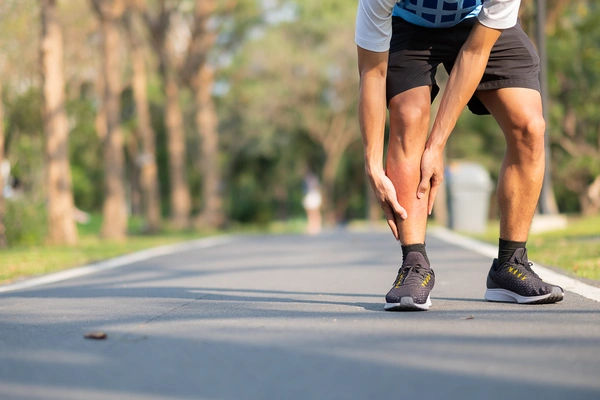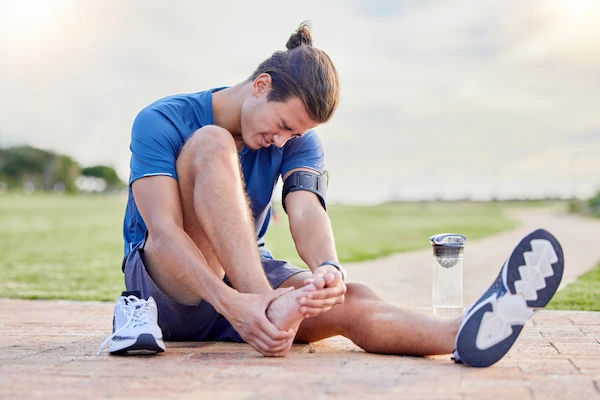The Ultimate Guide to Preventing Knee Injuries in Sports
Protect your knees with expert tips on preventing sports injuries. Learn about common causes, warm-up routines, strengthening exercises, and proper techniques for safe play.

Written by Dr. Siri Nallapu
Reviewed by Dr. Rohinipriyanka Pondugula MBBS
Last updated on 17th Sep, 2025

Your knees are incredible feats of engineering, absorbing immense force with every step, jump, and pivot. But for athletes and weekend warriors alike, they are also a prime site for painful, season-ending injuries. From the sudden pop of an ACL tear to the nagging ache of runner's knee, sports-related knee problems are notoriously common. The good news? The majority of these injuries are preventable. This comprehensive guide moves beyond basic tips, diving into the why and how of building resilient knees. We'll explore the anatomy of your knee, break down the most common injuries, and provide an actionable blueprint—encompassing strength, technique, recovery, and gear—to keep you in the game and out of the doctor's office. Whether you're a seasoned competitor or just starting your fitness journey, protecting your knees is the most important training you'll ever do.
Understanding How Your Knee Works: Anatomy of a Joint
To protect your knee, you must first understand what you're protecting. The knee is not a simple hinge joint; it's a complex structure that bears weight, allows rotation, and provides stability.
The Crucial Ligaments: ACL, PCL, MCL, LCL
Ligaments are tough, fibrous bands that connect bones to other bones. The four primary ligaments act as your knee's security system:
• ACL (Anterior Cruciate Ligament): The most commonly injured ligament in sports. It controls rotation and forward movement of the shin bone.
• PCL (Posterior Cruciate Ligament): Controls backward movement of the shin bone.
• MCL (Medial Collateral Ligament): Provides stability to the inner knee.
• LCL (Lateral Collateral Ligament): Provides stability to the outer knee.
Injuries often occur when these ligaments are stretched or torn due to sudden stops, changes in direction, or direct impact.
The Menisci: Your Natural Shock Absorbers
Wedged between the thigh bone (femur) and shin bone (tibia) are two C-shaped pieces of cartilage called the menisci. They act as crucial shock absorbers, distributing weight and reducing friction in the joint. A sudden twist while bearing weight can easily tear this cartilage.
Strength Training for Knee Stability
Strength training is the cornerstone of knee injury prevention. It's not just about building big muscles; it's about creating a stable, supportive structure around the joint.
Don't Neglect the Chain: Hip and Glute Strengthening
This is the most overlooked aspect of preventing sports injuries. Your knees are victims of your hips. Weak glutes and hips lead to poor leg alignment, causing the knee to cave inwards (valgus collapse) during squats, jumps, or lunges—a primary mechanism for ACL and other ligament tears.
• Key Exercises: Clamshells, hip thrusts, lateral band walks, and single-leg deadlifts.
• Data Point: A study in the American Journal of Sports Medicine found that athletes who followed a neuromuscular training program focused on hip and core strength reduced their risk of ACL injury by over 50%.
Consult Top Specialists
Quadriceps and Hamstrings: The Dynamic Duo
Your quadriceps (front of thigh) and hamstrings (back of thigh) work in concert to stabilise the knee. A strength imbalance between these two groups is a key risk factor for injury. The goal is to have strong hamstrings to counter the powerful pull of the quads.
Key Exercises:
• For quads: squats and lunges.
• For hamstrings: Romanian deadlifts and hamstring curls.
The Importance of Technique and Form
You can be strong, but if you move poorly, you're still at high risk. Proper technique is what allows your strength to protect you.
Mastering the Athletic Stance and Landing Mechanics
This is critical for preventing ACL tears and meniscal injuries. The dangerous position is a straight-legged, upright posture with knees collapsing inward.
• The Safe Position: Always land from a jump "softly" with hips back, knees bent, and chest forward—like sitting in a chair. Your knees should track in line with your toes, never caving inward.
• Drill: Practice drop jumps from a small box, focusing on a quiet, controlled landing held for 3 seconds. This trains your nervous system to adopt safer patterns.
Listen to Your Body: The Role of Rest and Recovery
Overtraining is a fast track to an overuse injury like patellofemoral pain syndrome (runner's knee) or tendinitis. Your body needs time to repair and strengthen.
Recognising the Difference Between Pain and Soreness
• Muscle Soreness (DOMS): A general, dull ache that feels like stiffness. It usually peaks 24-48 hours after exercise and resolves quickly.
• Pain: Sharp, stabbing, or specific. Pain that causes a limp, swelling, or joint instability is a red flag. If pain persists during or after activity for more than two weeks, it's wise to consult a doctor online with Apollo24|7 for a professional evaluation to rule out a serious underlying issue.
When Home Care Isn't Enough?
While prevention is powerful, accidents happen. You should seek immediate medical attention if you experience:
• A popping or snapping sound at the time of injury.
• Severe pain or inability to bear weight on the leg.
• Significant or sudden swelling.
• A feeling of instability or "giving way" in the knee.
• Visible deformity of the joint.
For less severe but persistent issues, if your condition does not improve after trying rest, ice, and these prevention methods, book a physical visit to an orthopaedic specialist with Apollo24|7 for a thorough diagnosis and imaging, which may be needed to assess ligament or meniscal damage.
Conclusion
Preventing knee injuries in sports isn't about living in fear; it's about playing with confidence. It's a proactive commitment to building a body that is not only powerful and skilled but also resilient and durable. By integrating intelligent strength training, mindful movement techniques, and dedicated recovery into your routine, you are investing in your long-term athletic health. This guide provides the blueprint—your job is to execute it consistently. Remember, the best surgery is the one you never need. Take these steps to heart, listen to your body, and empower yourself to enjoy the sports you love for years to come, with strong, healthy knees supporting you every step of the way.
07337088-ca54-4e67-8c53-6a5c03b07a7f
Consult Top Specialists

Dr. Anil Pradeep Jadhav
Orthopaedician
23 Years • MBBS MS (Ortho)
Nashik
Apollo Hospitals Nashik, Nashik
(25+ Patients)

Dr. Gopal Achari
Neurosurgeon
20 Years • MBBS, MS (GEN SUR), MCH (NEURO SUR)
Kolkata
Apollo Multispeciality Hospitals , Kolkata, Kolkata

Ms. Richa Sharma
Physiotherapist And Rehabilitation Specialist
12 Years • MPT,MIAP
Noida
Apollo Hospitals Sector 26, Noida

Dr Sunita Samleti
Oncologist
18 Years • M.D. (Pathology)- TN Medical College, Mumbai University, Mumbai, Mar 2005 M.B.B.S. Grant Medical College, Mumbai University, Mumbai, Oct 1999
Chinagadila
Apollo Hospitals Health City Unit, Chinagadila

Dr. Murali Mohan C R
Oral and Maxillofacial Surgeon
15 Years • MBBS, MDS, DNB, FFDRCS, MOMSRCPS, Fellow in Cleft lip & Palate Surg. & AO CMF
Bengaluru
Apollo Hospitals Sheshadripuram, Bengaluru
Consult Top Specialists

Dr. Anil Pradeep Jadhav
Orthopaedician
23 Years • MBBS MS (Ortho)
Nashik
Apollo Hospitals Nashik, Nashik
(25+ Patients)

Dr. Gopal Achari
Neurosurgeon
20 Years • MBBS, MS (GEN SUR), MCH (NEURO SUR)
Kolkata
Apollo Multispeciality Hospitals , Kolkata, Kolkata

Ms. Richa Sharma
Physiotherapist And Rehabilitation Specialist
12 Years • MPT,MIAP
Noida
Apollo Hospitals Sector 26, Noida

Dr Sunita Samleti
Oncologist
18 Years • M.D. (Pathology)- TN Medical College, Mumbai University, Mumbai, Mar 2005 M.B.B.S. Grant Medical College, Mumbai University, Mumbai, Oct 1999
Chinagadila
Apollo Hospitals Health City Unit, Chinagadila

Dr. Murali Mohan C R
Oral and Maxillofacial Surgeon
15 Years • MBBS, MDS, DNB, FFDRCS, MOMSRCPS, Fellow in Cleft lip & Palate Surg. & AO CMF
Bengaluru
Apollo Hospitals Sheshadripuram, Bengaluru
More articles from Sports Injury Prevention
Frequently Asked Questions
1. What is the most common knee injury from sports?
ACL (Anterior Cruciate Ligament) tears and meniscal tears are among the most common serious knee injuries, often caused by sudden stops, pivots, or direct impact. Patellofemoral pain syndrome (runner's knee) is the most common overuse injury.
2. Can knee braces prevent injuries?
Prophylactic knee braces (those worn to prevent injury) are controversial. For most athletes, evidence shows that strengthening the muscles around the knee through targeted exercises is far more effective for stability and preventing ligament sprains than relying on a brace. Braces are more useful for managing existing instability.
3. How can I strengthen my knees for running?
Focus on a holistic approach: strengthen your hips and glutes to control leg alignment, build hamstring strength to balance your quads, and incorporate calf raises for lower leg stability. Also, ensure you are not increasing your mileage too quickly.
4. What does a torn meniscus feel like?
Common signs of a meniscus tear include a popping sensation at the time of injury, stiffness and swelling, pain when twisting or rotating your knee, a feeling of your knee 'catching' or locking, and difficulty fully straightening your leg.
5. Are there any specific warm-ups to prevent ACL tears?
Yes, programs like the FIFA 11+ or PEP (Prevent Injury and Enhance Performance) Program are specifically designed to reduce ACL injury risk. They include dynamic stretching, neuromuscular training exercises focusing on core and leg strength, and plyometrics with an emphasis on proper landing technique.

